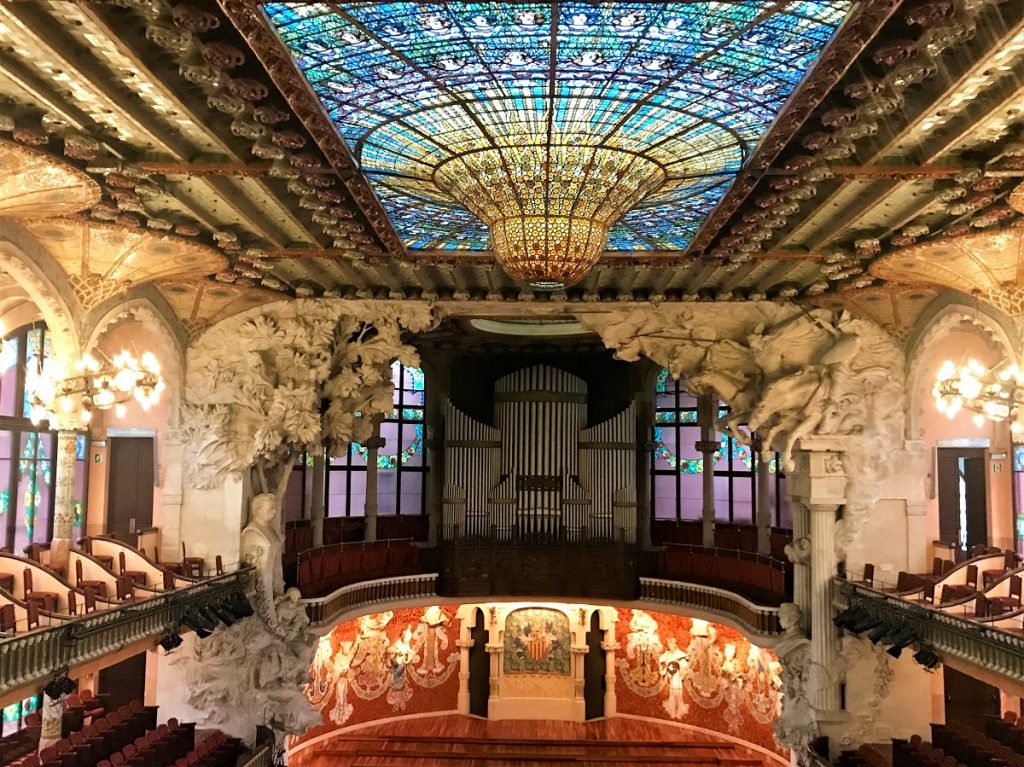One of the best things about visiting World Heritage Sites is discovering new styles of art, design and architecture, and one of my favourite discoveries has been the Catalan Modernism style.
This unique style of architecture, centred on Catalonia in north-eastern Spain, is closely related to art nouveau and dates from the early 20th century. It’s also called Catalan Modernisme.
There’s two main World Heritage sites designed in Catalan Modernism style. Read on for a closer look and videos of both of them!

1. Palau de la Catalan Musica & Hospital de Sant Pau – Catalan Modernism World Heritage Site
Lluís Domènech i Montaner, one of the most significant Catalan Modernist architects, designed this pair of buildings in Barcelona. First up is the Palace of Catalan Music, a gorgeously detailed concert hall in the centre of town. Elements of the Catalan Modernist style cover both the exteriors and interiors, bringing nature indoors with colourful porcelain roses, mosaics, and an incredible stained glass skylight.
Next is the Hospital de Sant Pau, a campus-style hospital development that was quite revolutionary for its time. Again, it has gorgeous colourful tiles and mosaics, beautiful windows and interiors, and plenty of natural light. Interestingly, the service corridors are buried underground which allows the hospital to operate without disturbing patients. The hospital was so well designed, it remained active until 2006!
2. Works of Antoni Gaudí in Barcelona – Catalan Modernism World Heritage Site
Antoni Gaudí is considered the most famous artist of Catalan Modernism. Gaudí is best known for the Sagrada Familia cathedral, but Barcelona is dotted with many of his other incredible works. Casa Batlló, Casa Milá, and Casa Vicens are a trio of gorgeous apartment buildings, all with a unique design element. Park Güell is a large parkland area with some beautiful Catalan Modernist features.
But Sagrada Familia still remains the highlight of any trip to Barcelona! The World Heritage listing actually only covers the immense Nativity facade and the crypt, which Gaudi personally designed. The beautiful interior and the impressive Passion facade aren’t actually on the World Heritage list! But the overall concept for the building is still Gaudi’s, and when the spires finally top out (current estimation: 2025), I can easily see the World Heritage listing expanded to include the full building.
Conclusion
Although there’s only two World Heritage Sites shown here, both sites cover multiple buildings. You can easily spend multiple days in Barcelona and Catalunya marvelling at the gorgeous archicture. Sights like the ones listed above have made Barcelona into one of the world’s most visited cities.
If you’re interested in modern architecture, be sure to check out our guide to the Best Modern Architecture World Heritage Sites! And as always, be sure to Subscribe to our YouTube channel, and click the notification bell so that you never miss a video.
